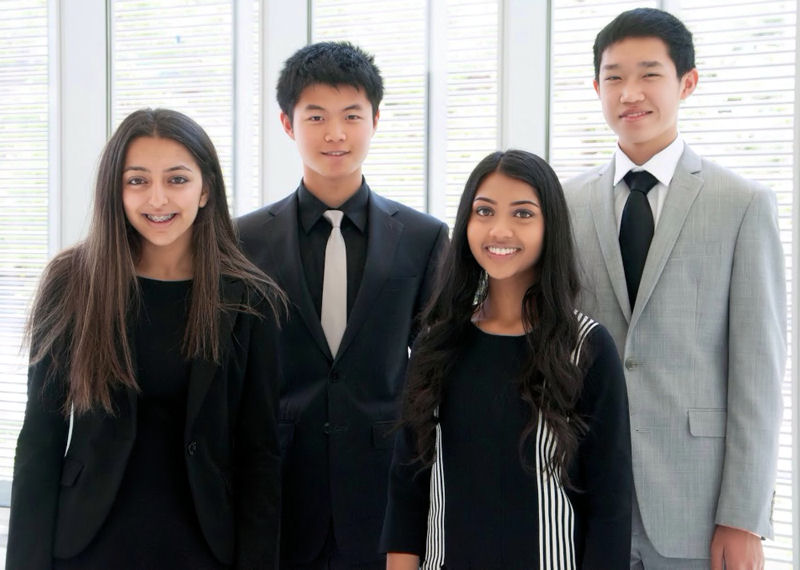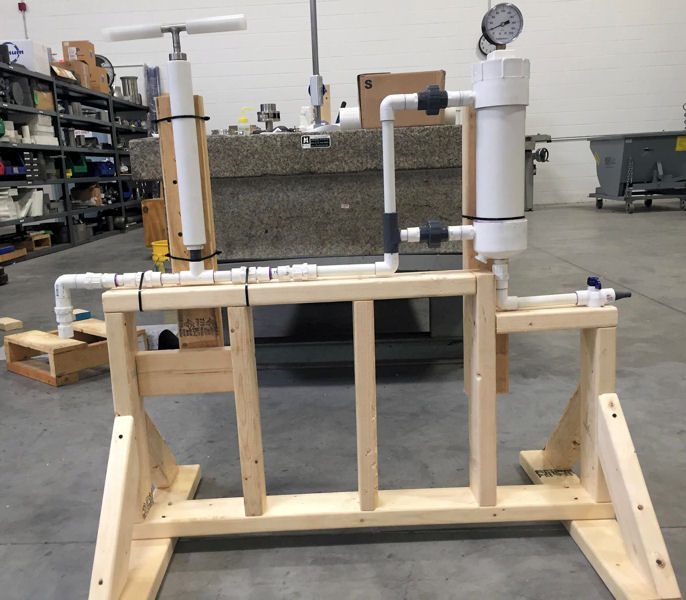
From left, Sanya Verma, Kai Lin, Mihika Nadig, and Tommy Yang bonded over a common interest in using technology towards social change during the 2016 MIT Launch Summer program. Photo courtesy of Mihika Nadig, VivaFlow.
This team of four young entrepreneurs already has accomplished a lot — after creating a self-powered device that transforms seawater into drinking water and receiving a letter of intent from the Bill and Melinda Gates Foundation (Seattle) — now they plan to graduate high school.
VivaFlow, a new company founded by high school students Kai Lin, Mihika Nadig, Sanya Verma, and Tommy Yang, focuses on providing clean drinking water solutions to those in coastal communities in developing countries. Their product, which hinges on convenience and portability, uses a reverse osmosis membrane to desalinate seawater and is operated via hand pump.
Just a few months ago, none of the founders knew each other. They met at a 4-week program that brings high school students to the Massachusetts Institute of Technology (MIT; Cambridge) campus, and pairs promising young entrepreneurs with faculty advisors and industry experts to establish enterprises. Verma, a native of Michigan, was paired up with Californians Lin, Nadig, and Yang through the MIT Launch Summer seminar. In 2016, only 70 students from around the world were admitted into the program.
“We all wanted to make great social impact,” Nadig said. “After learning about the prevalence of the water scarcity issue despite the filtration systems already on the market, we were shocked to see how this issue still persisted at such high levels.”

The VivaFlow prototype attempts to scale-down the desalination process. The final version is expected to be about the size of a 3.8 L (1 gal) milk jug. Photo courtesy of Mihika Nadig, VivaFlow.
The students created a system that produces 2551 kPa (370 lb/in.2) of pressure using a series of valves and pipes that filter impurities, bacteria, viruses, and salt from seawater. Its completed version is expected to be the size of a milk jug, to weigh less than 2.7 kg (6 lbs), and to pump 3.8 L (1 gal) of clean water every 20 minutes, according to an article that appeared in the Detroit Free Press.
Similar desalination devices already are available, but they tend to be too large and too expensive for widespread use, and they require external energy sources like electrodialysis or sunlight to function, according to the article.
“Our system will have a 70% output compared to the usual 50% other reverse osmosis systems have,” Nadig said.
Once the device is finished and ready for full-scale production, VivaFlow’s goal is to work with nonprofit organizations to bring their product first to Haiti and then to other coastal communities in need of their system. The team will receive guidance from the Bill and Melinda Gates Foundation toward efficient distribution of VivaFlow to its target audience.
To help fund manufacturing and marketing, Lin, Nadig, Verma, and Yang hope to raise $10,000 by the end of August through a campaign on the crowd-funding platform IndieGogo.
Nadig advises other young entrepreneurs to think big but start small. “Start from the step that hasn’t been done yet, and that way you’re one step closer to solving that big problem. That’s what we did with VivaFlow,” she said.
— Justin Jacques, WEF Highlights








August 25, 2016
Featured